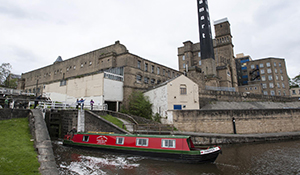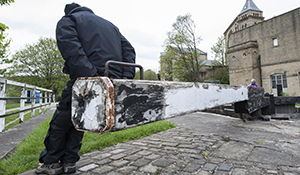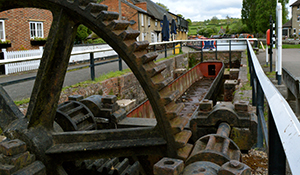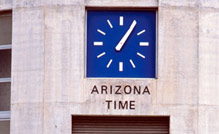Dive deeper into the history of how canals shaped a nation with OpenLearn.
For more information on the TV programme, Canals: The Making of a Nation, see the series page and episode guide here. Here, you can find out more about:
The canal capitalists

'Canal mania' was a boom period of frenzied activity that helped develop Britain's modern financial economy, from the relative simplicity of the industrial era to a new, complex system of deals, shares and investments requiring state regulation and safeguards. New canals were expensive and demanded large amounts of upfront investment. The first canals had been built by industrialists to support their businesses and transport their products, but soon canal companies began to form simply to get in the business of building new waterways to carry fuel and goods around the country, and charging companies and boat owners to use them.
Out of the industrial revolution came an emerging middle class and a new crop of business owners with money to invest. They put their cash to use by investing and speculating in the new inland waterways, making deals long before construction would be completed. Each new route had to be approved by the government and yet speculators would invest even before the Act of Parliament was granted. Demand for shares was huge – selling out almost instantly and exchanging hands for vast profits. New corporate rules were instigated to stop canal owners and boat owners from creating monopolies with the power to fix prices. In the space of only a few decades in the late 1700s, all sorts of bureaucracy, contracts and book-keeping systems emerged to satisfy investors calls for protection on their money.
The Grand Junction Canal (now part of the Grand Union Canal) - built to improve the connection between London and the Midlands - was one of the new routes. With the huge potential for profit from carrying coal and cargo to the capital, it eventually proved to be a good investment for shareholders. However, not all canals were profitable, scandal was rife and not everyone played by the rules. Some routes never saw construction and canal companies went bust. The new investors discovered that investment capitalism was a system that created winners and losers.
The canal workers
 The men who built our canals - the navigators or 'navvies' - were an 'army' of hard physical men who were capable of enduring tough labour for long hours. Many roved the countryside looking for work and a better deal. They gained a reputation as troublesome outsiders, fond of drinking and living a life of ungodly debauchery. But who were they? Unreliable heathens and outcasts, or unsung heroes who used might and muscle to build canals and railways?
The men who built our canals - the navigators or 'navvies' - were an 'army' of hard physical men who were capable of enduring tough labour for long hours. Many roved the countryside looking for work and a better deal. They gained a reputation as troublesome outsiders, fond of drinking and living a life of ungodly debauchery. But who were they? Unreliable heathens and outcasts, or unsung heroes who used might and muscle to build canals and railways?
The 1800s were a time of organised labour and campaigns for better working conditions. Friedrich Engels wrote The Condition of the Working Class in England in Manchester, where socialism and revolution were seen as an answer to the injustice faced by workers. By this time, the disparate and disorganised navvies had mostly moved across to the railway construction which had superseded the declining canal building industry. However, there was still the Manchester Ship Canal to complete - the swansong for the navvies and hailed as the greatest engineering feat of the Victorian Age.
Spurred on by extortionate fees charged by dock owners in Liverpool’s busy port, the industrialists of Manchester decided to build a canal all the way from the sea to the city, 36 miles inland. It was a huge undertaking, started in 1887 and completed six years later in 1893, and costing fifteen million pounds at the time – the equivalent of £1.65 billion today. At its peak, the project employed over 16,000 workers – and it was here, in 1889, that John Ward organised them into one group, the Navvies, Bricklayers’ Labourers and General Labourers Union.
Thomas Walker, on the other hand, an engineer who was the main contractor for the canal and had radical ideas and a vision for a new type of industry. Walker cared about the welfare of his workers and built homes and hospitals for them. Inspired by new thinking about health and safety, he built first aid centres all along the route. New technology, such as steam powered cranes, also helped but it was their enlightened boss that made the big difference in improving working conditions. The rhetoric embedded within rising trade unionism never turned into the class war that was feared and the Manchester Ship Canal successfully opened as the largest ship canal in the world.
The canal engineers

The early canal builders struggled with the rugged terrain of England's Pennine hills. Creating a network of canals in this landscape was an uphill challenge - sometimes literally! But connecting the powerhouses of Yorkshire and Lancashire was a great prize at the time of the industrial revolution. What should the engineers do? Should they build over, under or around the hills?
Civil engineering flourished in the era of canals, alongside advances in scientific understanding about the materials and methods engineers could use to build their industrial utopia. The money being made in the industrial revolution gave the early civil engineers a strong motivation to ‘make things work’ at all odds. The hills of the Pennines were a 2000ft high problem, and the hives of industry in Yorkshire and Lancashire needed to be connected – but how?
Two different engineering solutions presented themselves. Benjamin Outram’s plan was on the face of it rather simple: build a tunnel. He was consulting engineer for the pioneering Standedge tunnel on the Huddersfield narrow canal – at over 5km long and 200m above sea level, it’s still the both the longest and highest canal tunnel in the UK, and one of the so-called seven wonders of the waterways. Given the technology and understanding at that time, it was an extraordinary undertaking, with plenty of challenges along the way. The dig started from both sides of the hill, so getting the two tunnels to meet in the middle was an achievement in itself. Boats had to be powered by workers’ legs, walking along the tunnel walls, to get through the 5km stretch. Issues with money, excess water drainage, and losing their chief engineer, Outram, who left before construction was complete, threatened to derail the project. Thomas Telford, another visionary engineer, stepped in to finish the job however and the tunnel was a success.
Today, the Leeds-Liverpool canal cuts through the Pennines, but this time with the clever use of locks, embankments and cuts. It was the first trans-pennine route to be started, but the last to be completed, taking 46 years to build and stretching for 127 miles with 91 locks. This canal connected Yorkshire with the Irish Sea, its ports, and the rest of the world, becoming a vital link for industry.




Rate and Review
Rate this article
Review this article
Log into OpenLearn to leave reviews and join in the conversation.
Article reviews